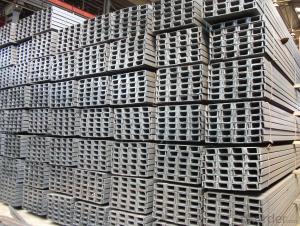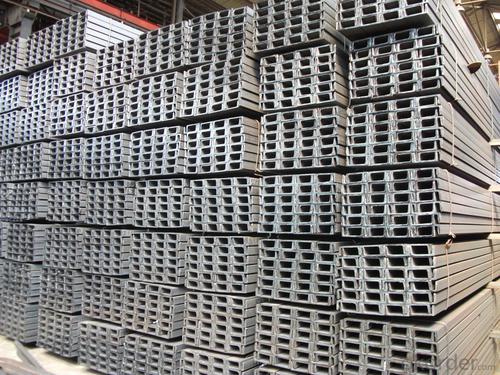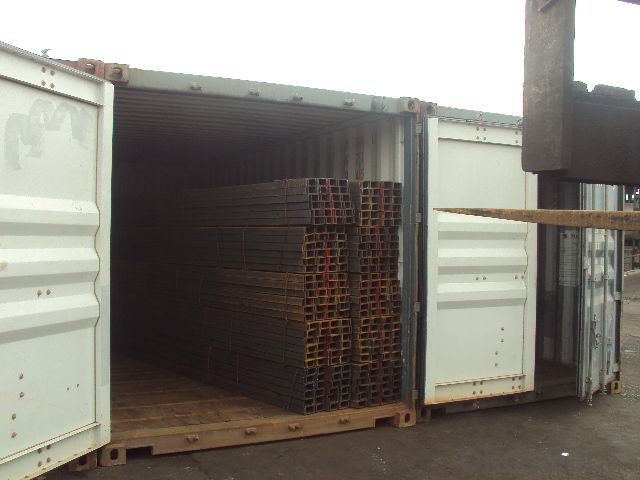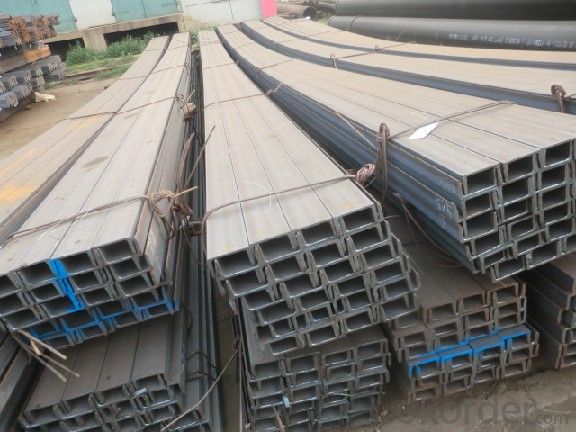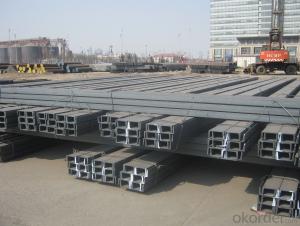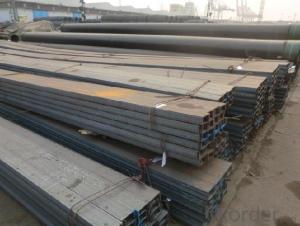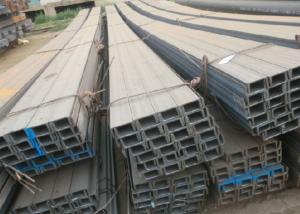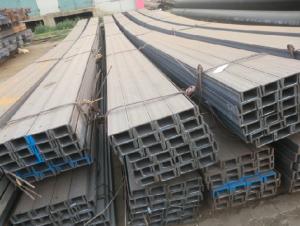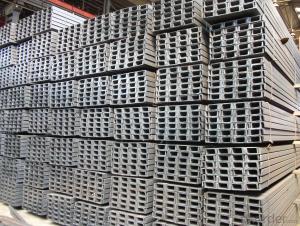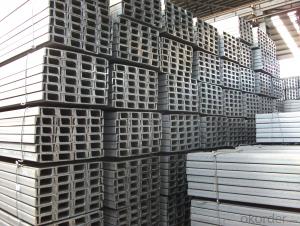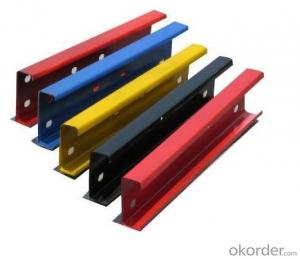channel
- Loading Port:
- China Main Port
- Payment Terms:
- TT OR LC
- Min Order Qty:
- -
- Supply Capability:
- -
OKorder Service Pledge
OKorder Financial Service
You Might Also Like
Product Description:
Specifications of MS Channel:
1.We supply high quality MS Channel at reasonable price, including Chinese standard, Japanese standard and so on.
Standard | GB/JIS |
Material Grade | Q235,SS400 |
Technique: | Hot Rolled |
Sizes as per chinese standard: | 50*37*4.5mm - 300*89*11.5mm |
Sizes as per japanese standard: | 50*25*3mm – 200*80*7.5mm |
Length: | 6meter, 9meter, 12meter |
Note: 1.we are also competent to provide our customers other MS Channel based on other sizes according to customer’s requirements.
2. The length of our ms channel could be cut into other meters as per customer’s requirements. For example, the channel in 6meters could be cut into 5.8meters in order to be fit in the 20ft container.
2. The detailed sections of MS Channel as per GB standard.are shown in the table-1:
GB U CHANNEL | Standard | Sectional | Dimension |
| Mass: |
| (mm) | (mm) | (mm) | (mm) |
|
50X37 | 50 | 37 | 4.50 | 7.0 | 5.438 |
63X40 | 63 | 40 | 4.80 | 7.5 | 6.634 |
80x43 | 80 | 43 | 5.00 | 8.0 | 8.045 |
|
|
|
|
|
|
100x48 | 100 | 48 | 5.30 | 8.5 | 10.007 |
120x53 | 120 | 53 | 5.50 | 9.0 | 12.059 |
140x58 | 140 | 58 | 6.00 | 9.5 | 14.535 |
140x60 | 140 | 60 | 8.00 | 9.5 | 16.733 |
|
|
|
|
|
|
160x63 | 160 | 63 | 6.50 | 10.0 | 17.240 |
160x65 | 160 | 65 | 8.50 | 10.0 | 19.752 |
|
|
|
|
|
|
180x68 | 180 | 68 | 7.00 | 10.5 | 20.174 |
180x70 | 180 | 70 | 9.00 | 10.5 | 23.000 |
|
|
|
|
|
|
200x73 | 200 | 73 | 7.00 | 11.0 | 22.637 |
200x75 | 200 | 75 | 9.00 | 11.0 | 25.777 |
|
|
|
|
|
|
220x77 | 220 | 77 | 7.00 | 11.5 | 24.999 |
220x79 | 220 | 79 | 9.00 | 11.5 | 28.453 |
|
|
|
|
|
|
250x78 | 250 | 78 | 7.00 | 12.0 | 27.410 |
250x80 | 250 | 80 | 9.00 | 12.0 | 31.335 |
250x82 | 250 | 82 | 11.00 | 12.0 | 35.260 |
|
|
|
|
| |
280x82 | 280 | 82 | 7.50 | 12.5 | 31.427 |
280x84 | 280 | 84 | 9.50 | 12.5 | 35.823 |
280x86 | 280 | 86 | 11.50 | 12.5 | 40.219 |
|
|
|
|
|
|
300x85 | 300 | 85 | 7.50 | 13.5 | 34.463 |
300x87 | 300 | 87 | 9.50 | 13.5 | 39.173 |
300x89 | 300 | 89 | 11.50 | 13.5 | 43.883 |
Table-1
3. The chemical composition of HR Channel Steel according to Q235B is shown in Table-2.
Alloy No | Grade | Element(%) | ||||
C | Mn | S | P | Si | ||
Q235 | B | 0.12-0.20 | 0.3-0.7 | ≦0.045 | ≦0.045 | ≦0.3 |
Table-2
Note: we are able to present our customers relevant SGS test report for chemical composition of HR Channel Steel.
4. The mechanical property of HR Channel Steel according to Q235B is shown in Table-3-1 and Table-3-2
Alloy No | Grade | Yielding Strength Point(Mpa) | |||
Thickness(mm) | |||||
≦16 | >16-40 | >40-60 | >60-100 | ||
≧ | |||||
Q235 | B | 235 | 225 | 215 | 205 |
Table-3-1
Alloy No | Grade | Tensile Strength(Mpa) | Elongation After Fracture(%) | |||
Thickness(mm) | ||||||
≦16 | >16-40 | >40-60 | >60-100 | |||
≧ | ||||||
G235 | B | 375-500 | 26 | 25 | 24 | 23 |
Table-3-2
Note: we are able to present our customers relevant SGS test report for mechanical property of MS Channel as customer’s request.
Applications of MS Channel:
The MS Channel can be applied to construction of warehouses, workshops, sport stadiums and car parks etc.The hot rolled channel steel belongs to carbon structural steel which is applied to in the field of construction and machinery.In details, the hot rolled channel steel is usually used for arch-itechtural structure, and they could be welded in order to support or hang a vari-ety of facilities. They are also usually used in combination with I beam. Generally,the hot rolled channel steel we supply must possess perfect welding property, riveting property and mechanical property and so on.
Package & Delivery of MS Channel:
1.The hot rolled channel steel will be packed in bundle with steel wire at each end of every bundle and color marking in order to help the customer to recognize his goods more easily at sight.
2. And the hot rolled channel steel could be loaded into 20ft or 40ft container, or by bulk cargo.If the weight of each bundle reaches more than 3.5 mt, the loading by break bulk cargo should be choosed.When the weight of each bundle reaches less than 3mt, the loading by container should be choosed.
3.As for the transportaion from mill to loading port, the truck will be usually used. And the maximum quantity for each truck is 40mt.
4.All in all, we could do in accordance with customer's request
- Q: Are steel channels suitable for soundproofing?
- No, steel channels are not suitable for soundproofing as they are conductive and can transmit sound vibrations.
- Q: What are the factors that affect the cost of steel channels?
- The cost of steel channels can be affected by several factors. Firstly, the cost of raw materials plays a significant role. Factors like supply and demand, production costs, and global economic conditions can directly impact the price of steel, thus affecting the cost of steel channels. Another factor that influences the cost is the size and specifications of the channels. Larger or more specialized channels may require additional processing or customization, leading to increased costs. The complexity of the design or the need for specific coatings or finishes can also impact the final price. The manufacturing process itself contributes to determining the cost. Different production methods, such as hot-rolling or cold-forming, have varying associated costs. Additionally, the location of the steel production facility and transportation costs can affect the overall price. Market conditions and competition also have a role in determining the cost of steel channels. When demand is high and supply is limited, prices tend to rise. Conversely, during periods of low demand or increased competition, prices may decrease. Lastly, any additional services or value-added features, like cutting, drilling, or welding, can increase the cost of steel channels. These services require additional labor, equipment, and expertise, resulting in an overall higher price. In conclusion, the cost of steel channels is influenced by various factors, including raw material prices, size and specifications, manufacturing process, market conditions, competition, and additional services. It is crucial for businesses and consumers to understand these factors in order to make informed decisions when purchasing steel channels.
- Q: What are the considerations for steel channel connections to steel beams?
- When considering steel channel connections to steel beams, several factors should be taken into account. Firstly, the load-bearing capacity of both the channel and the beam must be assessed to ensure the connection can support the anticipated loads. The size, shape, and material specifications of the channel and beam should also be compatible for a secure and stable connection. Additionally, the method of connection, such as welding or bolting, must be chosen based on factors like structural requirements, ease of installation, and potential future modifications. Proper alignment and positioning of the channel and beam during the connection process is crucial to maintaining structural integrity. Finally, adherence to relevant building codes and industry standards is essential to ensure safety and compliance with regulations.
- Q: Are steel channels suitable for use in warehouse storage systems?
- Yes, steel channels are suitable for use in warehouse storage systems. Steel channels provide a strong and durable framework for supporting heavy loads in a warehouse. They are capable of withstanding the weight of various storage items and can be utilized in various storage configurations such as pallet racking systems, shelving units, or mezzanine platforms. Steel channels are resistant to damage, corrosion, and wear, ensuring a long lifespan for the storage system. Additionally, they can be easily customized and adjusted to accommodate different storage needs and configurations, making them a versatile choice for warehouse storage systems.
- Q: What are the different methods of corrosion protection for steel channels?
- Steel channels can be protected from corrosion using various methods, each with its own advantages and suitability for different environments. Some commonly used methods are: 1. Galvanization, which involves applying a layer of zinc to the steel channel. The zinc acts as a sacrificial anode, corroding in place of the steel and protecting it from corrosion. Galvanization can be done through hot-dip or electro-galvanization. 2. Painting or Coating, where a protective paint or coating is applied to create a barrier between the steel and corrosive elements. Different types of paints and coatings, like epoxy or polyurethane, offer varying levels of corrosion resistance and durability. 3. Cathodic Protection, which connects the steel channel to a sacrificial anode, like zinc or aluminum, to create an electrical circuit. The anode corrodes instead of the steel, effectively protecting it. This method is particularly useful in submerged or buried environments. 4. Stainless Steel, which contains chromium that forms a passive oxide layer on the surface, providing excellent corrosion resistance. Stainless steel channels are commonly used in industries where corrosion resistance is crucial, such as marine or chemical industries. 5. Corrosion Inhibitors, chemicals that can be applied to slow down or inhibit the corrosion process. They form a protective film on the surface or alter the chemical environment around the steel. However, their effectiveness may vary depending on the application and environment. When selecting a corrosion protection method for steel channels, factors such as the operating environment, anticipated lifespan, and budget should be considered. Consulting with corrosion experts or engineers can help determine the most suitable and cost-effective method for a specific application.
- Q: What are the different types of connections used for steel channels in bridges?
- Steel channels in bridges can be joined using various types of connections, each with its own benefits and considerations. Some commonly used connection types are as follows: 1. Welded connections: Welding is widely employed to connect steel channels in bridges. This method involves heating the materials until they melt and then fusing them together. Welded connections are renowned for their strength and durability. However, skilled labor and proper quality control are necessary to ensure the integrity of the welds. 2. Bolted connections: Bolted connections entail using bolts and nuts to fasten steel channels. This type of connection offers flexibility as it allows for disassembly and reassembly if required. It is also relatively easier to install and inspect compared to welded connections. Nevertheless, periodic maintenance may be needed to ensure the bolts remain tight. 3. Riveted connections: In older bridge constructions, rivets were commonly used. This method involves inserting a rivet into a pre-drilled hole and deforming it to secure the steel channels. Riveted connections provide good shear resistance, but they are less frequently used today due to the labor-intensive installation process and difficulties in inspection and maintenance. 4. High-strength bolted connections: High-strength bolts, which possess greater tensile strength than regular bolts, are commonly employed in modern bridge constructions. These connections offer high resistance to shear and tension forces. Specialized tools and careful installation are required to achieve the desired strength. 5. Moment connections: Moment connections are designed to transfer bending moments between steel channels in bridges. They are typically used in situations where the bridge is subjected to significant lateral forces, such as in earthquake-prone areas. Moment connections are usually welded and necessitate meticulous design and analysis to ensure their performance under different loading conditions. It is important to consider various factors, including bridge design, anticipated loads, construction techniques, and maintenance requirements when selecting connection types. Engineers and designers take these factors into account to determine the most suitable connections that will provide the necessary strength, durability, and safety for steel channels in bridges.
- Q: Can steel channels be used for residential construction projects?
- Certainly! Residential construction projects can utilize steel channels effectively. Steel channels, which are commonly used in the construction industry, are versatile structural components that provide strength and stability to buildings. They are suitable for various applications, including residential construction. Steel channels have a wide range of uses, such as supporting and reinforcing structural elements like walls, roofs, and floors. Depending on the project's specific requirements, they can serve as beams, columns, or purlins. These channels come in different sizes and thicknesses, allowing for flexibility in design and construction. The durability of steel channels is one of their advantages in residential construction. Steel is a strong and long-lasting material that can withstand the test of time, ensuring the building's structural integrity. Moreover, steel channels are resistant to fire, pests, and rot, making them a reliable choice for residential projects. Another benefit of using steel channels is their cost-effectiveness. Although steel may have a higher initial cost compared to materials like wood or concrete, its long-term benefits, such as reduced maintenance and repair costs, make it a cost-effective option. Additionally, steel channels require less labor and time for installation, contributing to overall cost savings. Furthermore, steel channels offer design flexibility. They can be easily fabricated and customized to meet specific project requirements. This allows for efficient construction and the ability to achieve desired architectural designs. In conclusion, steel channels are undoubtedly suitable for residential construction projects. Their strength, durability, cost-effectiveness, and design flexibility make them a reliable choice for builders and homeowners alike.
- Q: What are the disadvantages of using steel channels?
- There are a few disadvantages of using steel channels in certain applications. Firstly, steel channels tend to be heavy and bulky, which can make them difficult to handle and transport. This can add to the overall cost and complexity of a project. Additionally, steel channels are prone to corrosion and rusting, especially when exposed to moisture or harsh environmental conditions. This can lead to a decrease in structural integrity and a shorter lifespan for the channels. Regular maintenance and protective coatings may be required to mitigate this issue. Another disadvantage is that steel channels have limited versatility in terms of shape and size. They are typically available in standard shapes and sizes, which may not always be suitable for specific design requirements. Customization options can be limited and may come with additional costs. Furthermore, steel channels can be relatively expensive compared to other materials, especially if they are made from high-quality steel alloys. This can make steel channels less cost-effective for certain projects, especially when there are alternative materials that can fulfill the same purpose at a lower cost. Lastly, steel channels are poor insulators of heat and electricity. In applications where thermal or electrical conductivity is a concern, alternative materials may be more suitable. Overall, while steel channels offer many advantages such as strength and durability, it is important to consider these disadvantages before deciding to use them in a particular application.
- Q: Can steel channels be used in the construction of staircases?
- Yes, steel channels can be used in the construction of staircases. Steel channels are commonly used as stringers or supports for stairs due to their strength, durability, and versatility. They provide a strong structural framework for stairs and can be customized to fit various designs and dimensions. Additionally, steel channels offer excellent load-bearing capacity, making them suitable for both commercial and residential staircase construction.
- Q: How many tons per ton for channel 12?
- 12# channel height 120 mm, leg width 53 mm, waist thickness 5.5 mm, 12.06 kg / m, about 13.5 tons per ton, price about 3700 yuan per ton
Send your message to us
channel
- Loading Port:
- China Main Port
- Payment Terms:
- TT OR LC
- Min Order Qty:
- -
- Supply Capability:
- -
OKorder Service Pledge
OKorder Financial Service
Similar products
Hot products
Hot Searches
Related keywords
